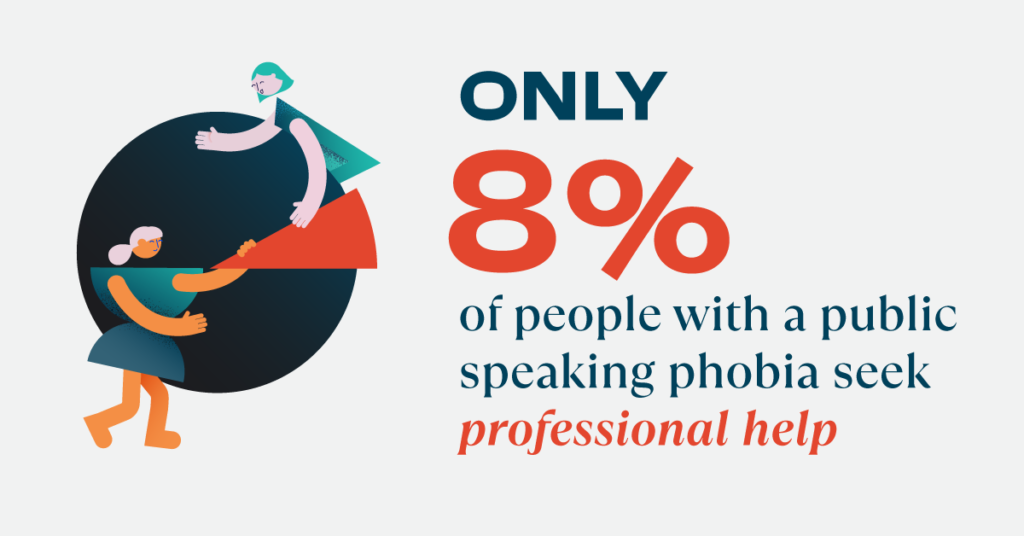
Yes, you can master public speaking. Here’s how.
Ever get that feeling of your throat slowly closing or trembling hands and legs when you have to speak publicly? Just the thought of having to present to an audience can cause major anxiety in a lot of people.
According to one study in the US, 74% of people suffer from speech anxiety. We become so afraid of being criticised that we forget that we have the power to share and spread a message.
If you suffer from a fear of public speaking, you’re not alone.
Mastering public speaking involves confidence, audience engagement and turning that anxiety into positive energy. It’s not nervousness, it’s excitement, right?…right?!
Here at Persuaders, we thrive on keeping people engaged and interested. So we’ve compiled a list of tools to tackle the art of public speaking.
Keep reading to learn some of the top public speaking tips that will have the audience wanting more and turning this haunting experience into a fun one.
Talk About What You Know
This should be a no brainer, but we’re going to say it anyway. You should be very comfortable with your topic. If you’re not, take the time to learn about it. If you are unsure, it will be obvious and you will lose credibility quickly.
However, when you are enthusiastic, knowledgeable and passionate about a topic, it will generally come across in the way you speak and your body language. These factors improve audience engagement and boost authority.
Don’t Stress Over Memorising Your Speech
It is common for presenters to rely on recitation because people often believe they have a lower chance of making a mistake if they know their speech by heart. However, trying to memorise and recite a speech tends to make a lot of people seem robotic and dry.
Instead, give yourself bullet points and/or visual cues that will prompt you to ensure you stay on track throughout. Effective presentation design can guide you and help you drive your message home with the audience, as words alone typically result in a 10% recall, but adding visuals boosts that number to an incredible 65%!
Plus, 91% of people say that they would feel more confident if they knew their presentation was beautifully designed. A little extra confidence never hurt a nervous speaker!
Structure Your Speech In A Way That Is Memorable
One of the most common issues people run into when public speaking is having too much to say and too little time. When you try to cram in multiple messages and reams of data, nothing really stands out and the audience ends up confused. Applying a tried and tested structure can help you refine the information you want to include and how it is delivered.
When constructing your speech, there are lots of formats you can follow. At Persuaders, our favourite is to create a story using our seven step narrative structure (learn more about that here). This ensures clear and effective communication, creating an emotional connection between the presenter and the audience.
Here is our narrative structure:
- Audience – Who are they? What do they want?
- Problem – What are their internal, external and philosophical problems?
- Guide – Who are you? How will you help the audience?
- Plan – Give them clear steps to solve their problem.
- Call to Action – Encourage the audience to take action now.
- Failure – Outline the negatives things your audience will experience if they don’t take action.
- Success – Demonstrate the benefits the audience will experience if they do engage with your business.
Get The Audience Involved
65% of people say they’re more easily persuaded by presentations that include a two-way interaction. That may not always be appropriate, but there are lots of ways to keep your audience engaged. Try to relate to them. You can get them thinking and/or directly involved with these techniques:
- Start with an icebreaker to welcome conversation and start the presentation in a fun, productive way. This can be something that involves the whole group talking for smaller audiences or setting the stage by telling a story about yourself that relates to the topic and gives them a sense of your personality.
- Use metaphors, similes, and analogies to creatively provide examples that make connections or comparisons.
- Use rhetorical questions to direct the audience’s attention to an important topic, draw a contrast or stimulate thinking.
- Share a personal experience relating to the subject matter, or a case study to create relevance and provide context for the audience.
- Joke! Even serious topics can have a bit of humour. Use your best judgement, but don’t be afraid to throw in a witty remark here and there.
- Appeal to human emotions as this is the most powerful tool you can leverage. If you can engage people emotionally you will significantly increase your influence and power in any situation.
- Use inclusive language to frame speech in a way that promotes diversity and shows respect to all groups.
- Quiz your audience – No, not in a scary teacher way, but as a way of getting them involved and drawing connections between different parts of your presentation (e.g., “who remembers the first rule of public speaking I mentioned earlier?”)
Warm Up On The Day
If you’re one of the 74% of people who suffer from speech anxiety, practising and having a relaxing warm up is essential. Even the most practiced and confident public speakers can feel a bit of stress and self-consciousness surrounding a speech or presentation.

Beat nerves before presenting with a warm up routine.
Here are some simple options:
- Breathing exercises: The easiest option is inhaling through your nose for 5-10 seconds, then exhaling through your mouth for 5-10 seconds. This settles your nervous system and refocuses your brain, distracting you from all that worry.
- Vocal warmups: This can be as simple as humming. This prepares and strengthens your voice, whilst relieving tension in the body.
- Stretching: It may seem silly, but loosening up the body can reduce stress levels, so get that down dog going!
Presenting Skills
The first seven seconds are the most important when speaking publicly. Seven seconds – that’s how long you have to make a first impression in any environment. Therefore, it’s no surprise that starting strong is critical for laying the foundation of the speech or presentation.
Wear something you feel confident in, use affirmations if you find them helpful, and practise!
If you want to deliver the best possible speech, you must rehearse! This can be achieved by first reading off the notes or palm cards, then adding eye contact, vocal variety and hand gestures. Strange as it may feel, practising in front of a mirror can be very helpful.
Once you feel you are confident enough, ask to rehearse in front of family, friends or colleagues – anyone you trust to give honest, helpful feedback. By rehearsing with them, you are not only increasing your confidence in your ability, you’re also opening yourself up to receiving positive feedback and helpful tips on things you can do to improve when it comes to the real thing.
When we are nervous, we also tend to say things such as ‘I think’, or ‘in my opinion’. While these qualifiers may seem harmless, they can actually make you appear less confident in your message (and therefore, less persuasive). Be mindful of them when you’re practising and try to minimise this type of language.
If one or two slip through, don’t beat yourself up! It’s totally normal.
Nonverbal Behaviour
According to one study, audiences take in 7% of your message from the words and 36% of the message from your voice. That leaves a whopping 57% hinging on nonverbal communication.
Here are some tips to improve your nonverbal behaviour:
- Body Language: Have open body language – don’t cross your arms or legs. Having an open posture improves your presence in the room and connects you to the audience.
- Hand Gestures: Avoid playing with your hands or hair as it indicates nervousness and can be distracting to your audience. You can overcome this by using hand gestures or holding onto a clicker to anchor your hands.
- Move Around: To exude confidence, purposefully move around. This can also bring you closer to different audience members across the room, which keeps them engaged.
- Eye Contact: By making and holding eye contact for around three seconds with different members of the audience, you will facilitate engagement, project confidence, and establish a connection.
The Value of Public Speaking Training
Only 8% of those who have a fear of public speaking seek professional help to become more effective and confident. By training and practising your public speaking skills, you will minimise the anxiety that comes with public speaking and feel prepared when your next speaking opportunity arises. You may even find it exciting!

Public Speaking training courses allow individuals to become clearer and more confident in all areas of speaking. The skills you’ll learn can even help when it comes to speaking up in meetings and groups, discussing a business deal, or selling an idea or product. Furthermore, it can provide the ability to handle difficult situations and express oneself with more clarity.
Most speakers never get feedback on how they present, and are unsure if their approach to public speaking is effective as a result. Working with a coach to hone your public speaking skills puts you in a setting where you’ll receive useful, pointed feedback, so you can improve not only your professional presence, but personal as well.
With greater confidence and clarity of self-expression comes the ability to improve negotiations and assertiveness. It’s clear that the benefits of public speaker training go well beyond the ability to give a presentation and can open all sorts of doors on a personal or professional basis.
What to Look For in A Public Speaking Course
If you and/or your team are looking for public speaking training, it can be difficult to narrow down the best options.
While each course and individual are different, here are some big inclusions to look for:
- Speech structure
- How to use humour to your advantage
- Improving stage presence through nonverbal communication
- Mastering anxiety and projecting confidence
- Tips to engage with and influence your audience
- Providing feedback and practise
If you don’t see these things listed, ask your coach or training company what their course covers and make sure it ticks these boxes.
Move Beyond the Public Speaking Tips
Here at Persuaders, we offer the expertise and knowledge to improve your public speaking with highly experienced coaches, available for individual or group training.
Our team will teach you how to deliver a powerful story that captures your audience, or help you gain the confidence to share your input in meetings. Contact us now to learn more!
